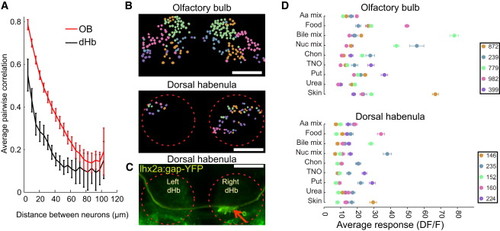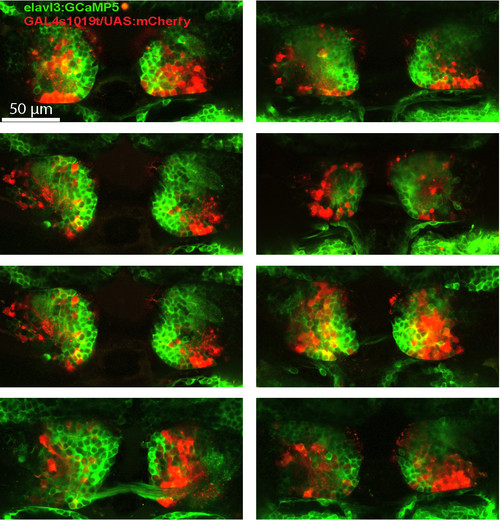- Title
-
Spontaneous activity governs olfactory representations in spatially organized habenular microcircuits
- Authors
- Jetti, S.K., Vendrell-Llopis, N., and Yaksi, E.
- Source
- Full text @ Curr. Biol.
|
Odor Response Properties of Olfactory Bulb and Dorsal Habenula Neurons (A) Raw images and food-odor-evoked activity map in the OB and dHb of 25-day-old elavl3:GCaMP5 zebrafish. (B) Example traces for odor responses in the OB and dHb. Colors of the traces correspond to the color of the arrows in (A). Black arrows mark the delivery of food odor. (C) Average odor responses of all recorded neurons in the OB (n = 3164 neurons, n = 9 fish) and dHb (n = 917 neurons, n = 8 fish) in response to nine different odors represented by different colors. DF/F is the percent change in fluorescence. (D) Average odor responses of OB versus dHb neurons in (C) averaged during the first 5 s. Error bars represent the SEM. (E) Histograms representing the distribution of odor responses in individual OB and dHb neurons. (C–E) Colors in all panels correspond to individual odors marked in the legend of (E). Odors were as follows: skin extract (skin), urea, bileacid mixture (bile mix), nucleotide mixture (nuc mix), chondroitin-6-sulfate (chon), trimethylamine-n-oxide (TNO), putrescine (put), aminoacid mixture (aa mix), and food odor. (F) Comparison of the odor responses of all individual OB and dHb neurons in response to bile acid mixture and amino acid mixture. Every individual semitransparent point is the response of a single OB or dHb neuron. (G) Correlation matrices representing the pairwise similarity between activity patterns evoked by different odors in the OB and dHb. Odors that are reported to be aversive are in red, and those reported to be attractive are in black. (H) Normalized odor responses of all individual OB and dHb neurons. Neurons on the y axis are sorted on the basis of their response selectivity. The least-selective neurons are on the top of the graph, whereas the most-selective neurons are on the bottom of the graph. Odor responses on the x axis are sorted on the basis of the response strength after normalizing to the strongest odor response of the individual neurons (warmest color) on the right side. A black dotted line is added to help with the comparison of the OB versus dHb. (I) Cumulative distribution of sparseness and skewness for the response profiles of all individual OB (red) and dHb (black) neurons. The sparseness and skewness of OB neurons of are significantly larger than those of dHb neurons (rank-sum test, p < 0.0001). See also Figures S1–S3. |
|
Spatial Organization of Odor Responses in the Olfactory Bulb and Dorsal Habenula (A) Relation between pairwise similarity of individual neurons odor responses and distance between OB and dHb neurons in microns. (B) Spatial distribution of neurons with similar response profiles in the OB and dHb. The neurons are grouped and colored on the basis of k-means clustering. (C) MC axon terminals (yellow) in the dHb of lhx2a:gap-YFP zebrafish (arrow). (B and C) Dotted red lines indicate the borders of the habenula. Scale bars represent 50 μm. (D) Average odor responses of all neural clusters in the OB and dHb. Each color corresponds to a cluster of neurons with similar odor responses, which also corresponds to the clusters of neurons in (B). Legends represent the number of neurons in different clusters. Error bars represent the SEM for the odor responses of neurons in each cluster. Note that the average cluster responses of OB neurons are stronger than the average cluster responses in the dHb. See also Figures S4 and S5. |
|
Spontaneous Activity in the Dorsal Habenula Is Structured into Functionally, Spatially, and Genetically Distinct Microcircuits that Govern Odor Responses (A and B) Spontaneous (A) and food-odor-evoked (B) activity of dHb neurons (y axis) are clustered using k-means clustering (left). Arrows indicate food-odor delivery. Spatial positions of dHb neurons in each cluster are marked with the corresponding cluster color (right). Scale bars represent 50 μm. (C) A significant portion of dHb neurons remained within the same functional cluster during spontaneous and odor-evoked activity (n = 11). This is higher than chance (rank-sum test, p < 0.0005). (D) Pairwise correlation of spontaneous and odor-evoked activity versus distance between dHb neurons. (E) elavl3:GCaMP5;GAL4s1019t/UAS:mCherry zebrafish dHb (top). The GAL4s1019t/UAS:mCherry neurons (red) are identified among other (green) dHb neurons (middle). Functional clusters in the dHb based on k-means clustering are shown (bottom). Note that the red neurons overlap with the cyan and blue functional clusters. (F and G) GAL4s1019t neurons (red) are represented by significantly fewer clusters (F) and have more correlated spontaneous and odor-evoked activity (G) than the remaining green neurons (n = 6; properties of red and green neurons in each fish are represented by one green and red circle connected by a line). Paired t test, p < 0.05, p < 0.005. See also Figures S6 and S7. |
|
Control responses to fish water in the olfactory bulb and the habenula. |
|
|
|
|
|
Individual examples for spontaneous and odor induced maps in all dHb experiments. |







